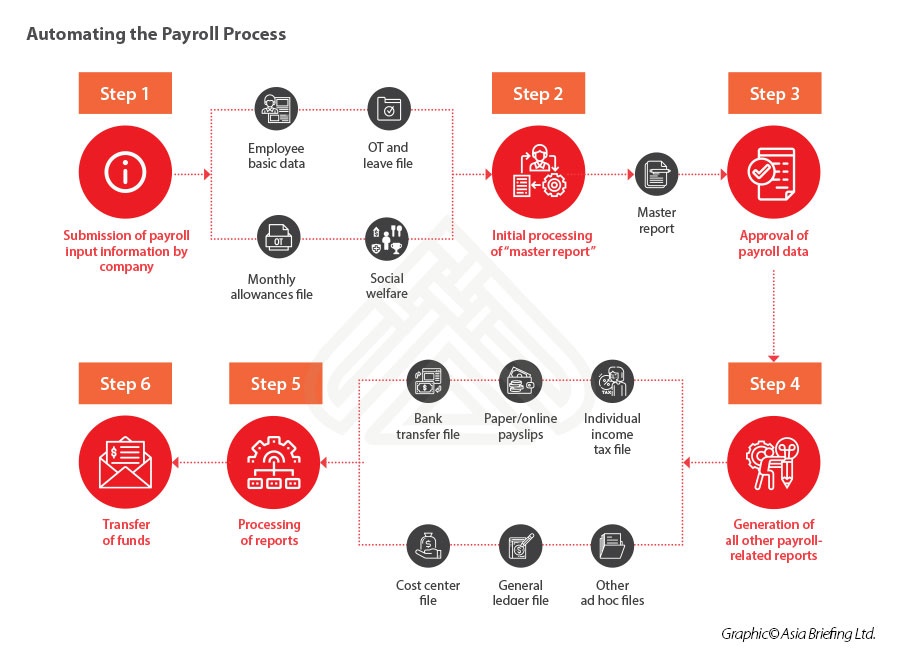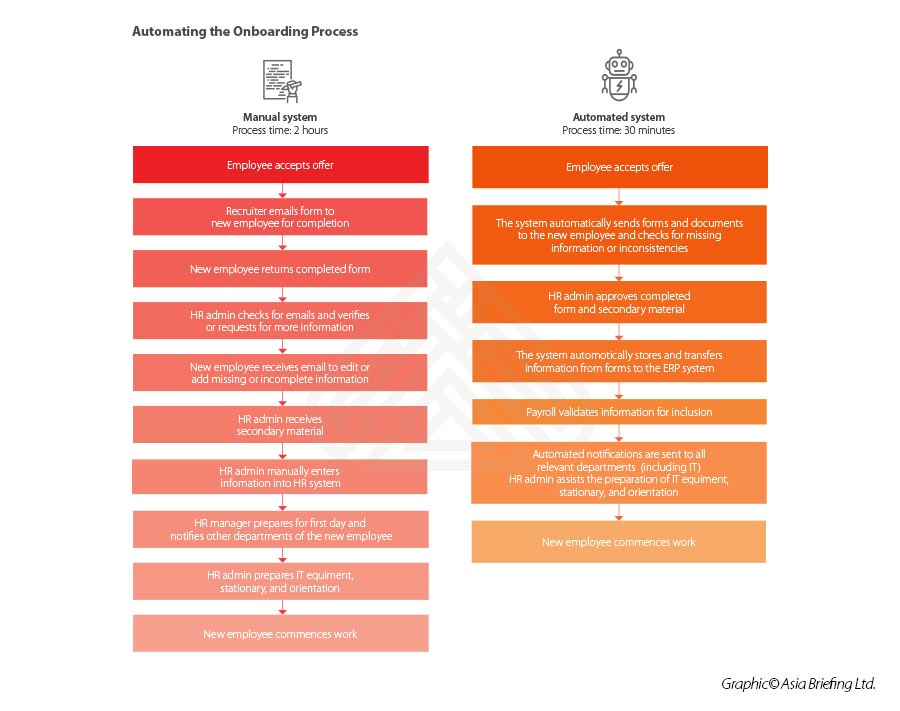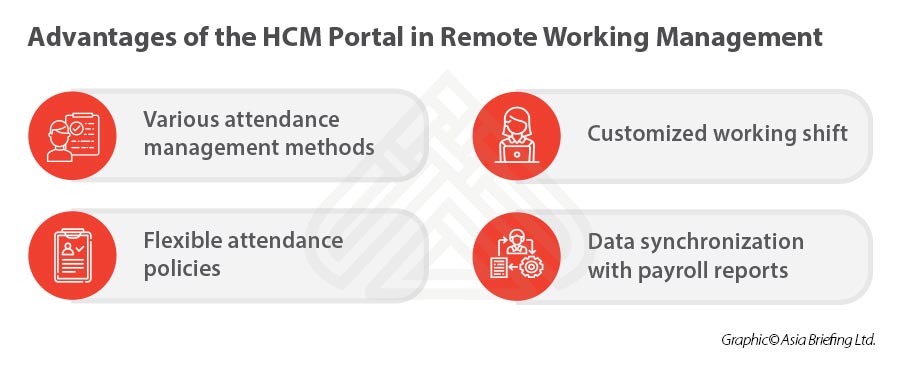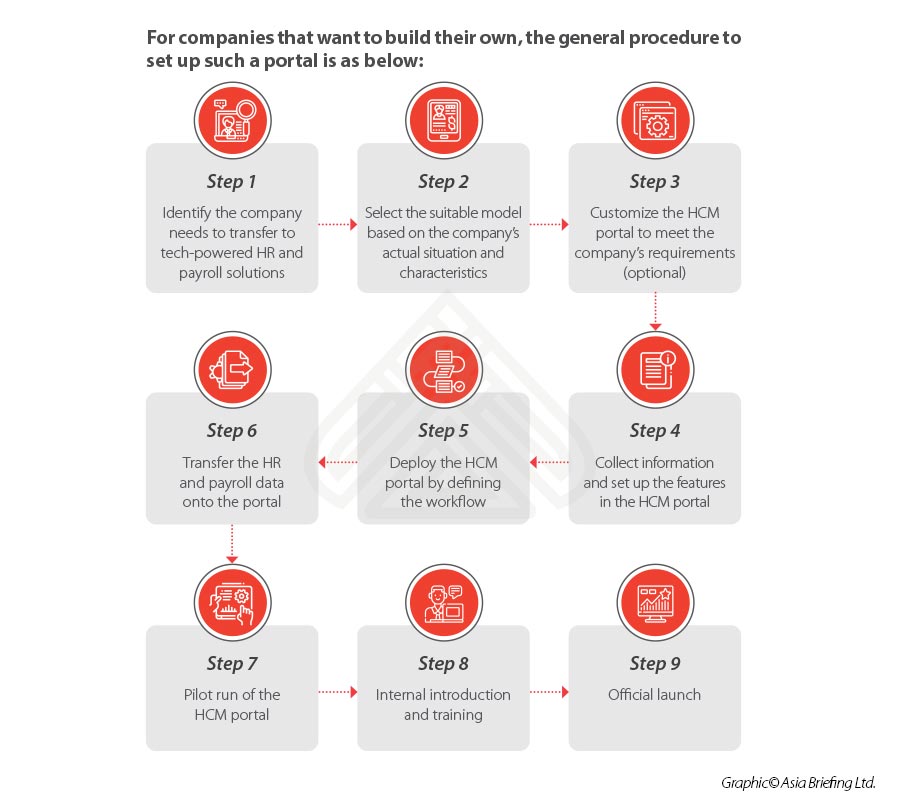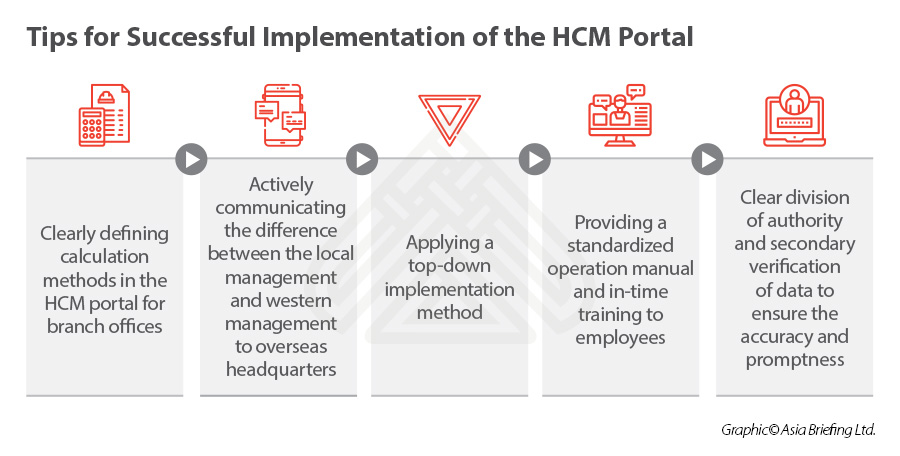Leveraging Technology to Improve HR and Payroll Management
More and more companies today are seizing upon the advantages of using a ‘tech-powered’ HR and payroll solution to help them with their China employee management. In doing so, they are transforming their businesses into more efficient and mobile operations, which better meet the norms of international business, with more capable apps or portals to serve their internal customers.
Further, businesses in China increasingly operate within a digital eco-system of government and supplier parties, facing a complex and ever changing compliance environment, with a slew of new COVID-19 factors to contend with as well. Modern HR applications have rapidly matured in the country and are able to deliver a far more effective HR service. Yet, such systems must fit and be viable for the specific company that uses them – and not all are alike.
Whether developed in-house, or provided by an HR and payroll service provider, an HR app must be technologically robust, well maintained by its provider for strict local compliance, and configured to be compatible and easy to use by each company that uses it. Therefore, a company must ensure that an HR system app is suitable in a number of areas, before beginning to use it.
To help companies understand the current innovation of HR system apps in China, and whether their subsidiaries might benefit from them, particularly given the new norms within a COVID-19 era, this article, part two of a two-part series, explains how today’s HR and payroll system apps in China address longstanding challenges and how to make important app selections to match operational needs. Part one summarized the pain points of traditional HR and payroll administration.
What is a tech-powered HCM portal?
Beyond the simple software management of payroll processing and HR administration, is the concept of a Human Capital Management (HCM) portal. Companies are increasingly moving away from separated, localized payroll software or Excel, and towards integrated HCM platforms that streamline multiple HR processes, often including onboarding, attendance, leave, claims, and possibly even areas like talent management and training (although this article primarily focuses on the former functions).
Such integrated HCM platforms offer a game changing shift in terms of how a company is able to manage its collective areas of HR internally, and even beyond the department and firm itself.
What kinds of processes can be integrated into the HCM portal?
Generally, the below processes can be integrated into the HCM portal:
- Standard HR processes, such as onboarding of employees or offboarding;
- Employment relationship management, such as probation, promotion, relocation, or termination;
- Contract management, including employment contract and renewal notifications;
- Attendance management;
- Employee time management;
- Leave application and approval;
- Claims management;
- Payroll computation;
- Visualization of the employee’s cost productivity; and
- Data analysis, such as generating reports and creating dashboards to analyze employee data.
How does the tech-powered solution work?
The HCM portal is easy to use and can be customized to fit the needs of the company but adoption is key. Beyond issues of adoption and compatibility, the functional value of a tech-powered solution and its benefits to the firm using it depends on how it:
- Integrates different processes onto a single platform;
- Standardizes the procedures of each process;
- Streamlines the data flow among the processes; and
- Optimizes the processes with mature technologies.
Take payroll processing for example.
A chief difficulty for payroll processors is how to best manage and process the mass amount of information that relates to their employees.
Typically, they are required to keep abreast of information relating to staff arrivals and departures, leave, salary increases, bonuses, allowances, mandatory benefits, and IIT payments. It is not uncommon for the company to demand time management sheets from their employees and managers as well.
Due to the high number of variables involved, HR administrators often struggle to maintain complete accuracy and high levels of efficiency during the payroll process. An automated payroll system can assist HR administrators by centralizing all the employees’ information in an online portal as seen in the diagram below.
This is particularly useful when dealing with multiple offices and languages; it will also save internal staff from having to manually fill in spreadsheets on a regular basis – a tedious and time-consuming task with a high margin for human error.
After the information is gathered, it can then be utilized to generate a master report, which calculates each employee’s respective salary, IIT, and social security obligations. It also assists in the production of other related reports, including the electronic funds transfer (EFT) file, pay slips, general ledger file for uploading into the financial system, cost center report, and IIT online filing document. Once all the payroll-related reports are properly processed, the funds will be transferred. As a general rule, the processing takes between six to 10 working days each month, with IIT online filing happening at the beginning of the following month.
An automated payroll process can enhance the implementation of the six steps described below in simple ways, such as scheduling the processing of payments in advance, spotting inaccurate or inconsistent information for correction, and identifying the relevant information for a quick generation of the master report.
Main advantages of the HCM portal
Compared with the classic HR and payroll processing via Excel or traditional software, an HCM portal automates the HR and payroll workflows and gives managers, the HR team administrators, and employees better and secure access to HR information and processes.
Below are several advantages that an HCM portal offers to companies in China.
Improving efficiency
An HCM portal can systematically streamline the routine processes of collecting, entering, updating, and analyzing data, which can fundamentally improve the efficiency of the organization. For example, the onboarding process of new staff takes around two hours in the traditional model, while under the tech-powered solution, it takes only about 30 minutes. It does this by amalgamating the process of submitting, receiving, and approving employee requests onto one single portal, with built-in notifications for both the supervisor and the employee.
Reducing inaccuracy
An HCM portal can reduce the risk of incompliance caused by inaccurate input. This is mainly achieved by increasing the portion of data that is collected automatically and transferring it to other processes and keeping double work to the minimum. For example, the attendance management in an HCM portal can achieve automatic punch in/punch out under the customized rules of the company, and the attendance data will automatically be transferred to the payroll module for employee welfare calculation. The same can be done for claims and leave applications. It can thus reduce the error of manual inputs.
Locally compliant payroll
Maintaining compliance and avoiding costly calculation errors requires up to date deduction and contribution factors. A reliable HCM portal that is managed by a reputable provider that has local knowledge will update processing factors and methods in a timely manner. This is vital to be done at national and city local levels. The next time that calculation or contribution factors change in your city, you will no longer need to worry about missing the update and having last month’s payroll be out of compliance.
Real-time data analysis
Most HCM portals generate analytical reports, from different business angles, which can produce valuable insights on company performances to help to optimize a business’ productivity. For example, the HCM portal can generate real-time attendance report of the employee at any given point of the month, which can visualize data into graphs and charts to complement HR processes and add daily updates via customized dashboards. Such clear records can help managers access an up-to-date knowledge of their employees’ performance whenever it is needed and help employees better plan and organize their daily schedules going forward. Such reports
should likely be secured so that only the right people have access, from wherever they may be in the world, and for that data to ideally be exportable and owned by the client company.
Data privacy and employee confidentiality
Manual HR processes often necessitates that employee data be stored together in spreadsheets and other ‘flat files’, and communicated perhaps all at once, by email. None of these methods are inherently confidential and most are likely to breach compliance sooner or later. By contrast, an HCM portal can allow HR data to be stored more securely and transmitted more confidentially and compliantly. With the right configuration, information is compartmentalized and individualized, and made available to only appointed managers in the organization, and/or individuals authorized to access select parts of their own records.
Depending on your chosen portal, access to information and approvals can be customized to multiple access levels to meet the scale and needs of a company. For example, a finance team might usually have access to only the final payroll amounts every month, and not the individual breakdowns. Meanwhile, a manager may view leave and claims but may not be privy to more personal employee information and some financial data. When choosing a system today, such configurations can fit an organization well, and not be costly to configure.
Advantages in remote working management
Under the ongoing COVID-19, the tech-powered HCM portal has an inherent advantage in managing HR and payroll for employees who work remotely. Since it integrates different processes relating to HR and payroll, the remote employee can be easily managed and self-serviced by following the pre-decided protocols set in the HCM portal. For example, the employee’s attendance can be automatically tracked by logging onto/off the HCM portal, which can be tracked and synced with the leave management and payroll calculation modules for other purposes. This way attendance, leave, and claims requests get processed seamlessly within the system. Managers can approve requests that contain better information, more easily and from any location, on the go.
This is far more practical than email and Excel in a post-COVID-19 era. This would be hard to achieve in the traditional HR and payroll processing method. HR and payroll administrators do not need to chase down changes and updates. A portal can help notify of deadlines and due actions. Your back office administrator can also complete their work from anywhere with far greater ease. This would be hard to achieve in the traditional HR and payroll processing model.
How to get started?
With so many advantageous features listed above, many companies, especially the smaller firms, may assume that adopting such a technology solution is expensive or beyond their budget. However, this is no longer the case. If the company chooses a SaaS or other cloud-based model, as most SMEs do, then it will be substantially cheaper than developing software and IT infrastructure by themselves.
The below issues need to be considered in the decision-making process.
Budget
The actual cost of an HCM portal will vary depending on the complexity of the company’s HR organization and payroll processing, their employee headcount, the extent to which customizations are required, and the preferred portal model and features.
It is time-consuming and costly to configure a customized HR software and manage the infrastructure by company’s internal resources alone, but for larger firms this may be the only option.
For smaller firms that do not have rigid corporate requirements for HR or highly complex attendance, claims, or payroll work – cloud-based models that are often far less costly can be considered. Cloud portals for small and medium sized companies have grown to become powerful, flexible, customizable, inter-connected, and are often very quick to launch.
Companies that outsource parts of their HR admin or payroll are advised to ask their provider to supply them with a solution. The options they provide should be measured against others in the market. Good providers should be able to offer a compliant China SaaS or other cloud-based HCM portal solution, as a part of their core service offering.
Consider key features
It’s important to create a list of features that are important for the business. Prioritize those features and separate the must-haves and nice-to-have features.
Compatibility of the HCM portal with the other systems of the company
To get the most from the HCM portal, the chosen solution should be compatible with the other systems being utilized by the company. For example, accounting, bookkeeping, and payroll calculating all have information that are required from each other. Only when the systems are compatible with each other, can the successful adoption of the HCM portal be achieved. This is one thing the company needs to work on together with the HCM provider.
State of system support
The end user of the HCM portal is the firm’s employees. As the HCM portal is supposed to liberate its employees from complex or time consuming processes, the firm must ensure there is due support to deal with enquiries and any unexpected situations once the system is launched. This is important especially at the initial transition phase.
As mentioned earlier, compliance is key, and staying on top of rapid and sometimes very localized changes can mean imminent changes required to an established HR policy or payroll calculations. It is vital to know how your HCM provider keeps these updated for the locations where you have offices and employees based in China.
Potential obstacles in adopting technology solutions
New tech-powered methods obviously have various advantages. However, they also bring extra pressures to the in-house HR staff and the company.
For example, the HR team might find it difficult when trying to figure out what is the most suitable solution for their company’s transformation to technology. In cases where there is lack of adequate IT support or if the internal IT advisor is not proficient enough, HR professionals may not be able to identify whether a specific option can fit into their current system, how it would fit in, and how to make the system as efficient and productive as possible. Selecting an appropriate software and a suitable vendor would be an extremely challenging and overwhelming task in such a scenario.
Then after choosing the automation model and the software, the company will find it hard to customize the system by themselves considering the standard solution might not 100 percent fit with the company’s actual situation. More often than not, the internal professionals will feel they lack the expertise and capabilities in this aspect, having no idea of what to do and where to start.
Moreover, for smaller firms, they may lack the resources and budgets to optimize and streamline the HR and payroll processes and keep them in line with China’s laws and regulations.
Use a third-party tech-powered service provider
Where the company doesn’t have the budget or time to develop its own internal team to handle the difficulties mentioned above, and doesn’t want to miss the automation trend to improve their business operations, one practical option is to cooperate with a third-party HCM service provider.
A qualified HCM service provider usually has rich knowledge and experience in both human capital management and technology applications. They hold the following advantages:
- They can easily grasp the needs of the client company, and integrate the service demands with the appropriate technologies.
- They can customize the HCM portal to meet particular requirements.
- They can provide training to the company’s in-house HR and other departments to ensure the smooth implementation of the system.
- They are also responsible for the maintenance of the portal and are dedicated to timely system updates for the purpose of full compliance with laws and local practices.
The last point is really a value-added service, considering the frequent changes to relevant legislation, from social insurance rates to individual income tax. This creates an extra level of complexity for the HCM portal. By constantly keeping an eye on these developments, the HCM service provider can save great trouble for clients by dealing with the complexities in the HCM portal caused by the regulatory updates, and provide an extra layer of safety to the company regarding its compliance status.
As to how to find a qualified third-party service provider, based on our experiences we list the below suggestions:
Firstly, the company should investigate the qualifications of the HCM service provider, such as the labor dispatch qualification. At the same time, the company is advised to pay attention to the legal proceedings and operating conditions of the HCM service provider to judge the company’s operational capability, level, and stability.
Secondly, the company is advised to check the previous companies and cases managed by the HCM service provider. The past practices can reflect the strength and operational ability of the HCM service provider.
Thirdly, the company is advised to pay attention to the service provider’s length of involvement in the market to analyze and estimate the company’s recognition, and whether it has sufficient operational experience.
Finally, the company’s network and service areas also need to be considered. It is important that the service provider can deliver an effective service to the company’s branch offices.
Tips for successful implementation
In the implementation of the integrated HCM portal, companies may encounter various obstacles and problems. The below tips can be referred to when optimizing the functions of the tech-powered solution:
- Companies should define different calculation methods in the HCM portal for their branch offices, considering that specific policies might be different in each region.
- Companies should actively communicate the difference between the local management and Western management to their overseas headquarters, and to gain a clear understanding of how to keep compliance in China and keep in line with the company’s group standards at the same time.
- A top-down implementation method is proved to be effective and efficient in the implementation of tech-powered solutions, considering employees sometimes are reluctant to transfer to a new system. Attention and participation from senior management can greatly reduce the implementation cycle.
- To get employees familiar with the new solution, a standardized operation manual and in-time training will be very helpful.
- In the process of collecting master data, clear division of authority and secondary verification of data are suggested to ensure the accuracy and promptness of the data.
Dezan Shira & Associates provide an integrated payroll service to clients across Asian countries. Using our cloud-based HR & Payroll portal gives your company access to a state-of-the-art HR and payroll system without having to invest in physical infrastructure – allowing your workforce to focus on core business.
For more information, please email us at HR@dezshira.com or visit our website www.dezshira.com.
About Us
China Briefing is written and produced by Dezan Shira & Associates. The practice assists foreign investors into China and has done so since 1992 through offices in Beijing, Tianjin, Dalian, Qingdao, Shanghai, Hangzhou, Ningbo, Suzhou, Guangzhou, Dongguan, Zhongshan, Shenzhen, and Hong Kong. Please contact the firm for assistance in China at china@dezshira.com.
Dezan Shira & Associates has offices in Vietnam, Indonesia, Singapore, United States, Germany, Italy, India, and Russia, in addition to our trade research facilities along the Belt & Road Initiative. We also have partner firms assisting foreign investors in The Philippines, Malaysia, Thailand, Bangladesh.
- Previous Article Challenges of Traditional HR and Payroll Management in Post-COVID Era
- Next Article China’s Carbon Neutrality Pledge: New Opportunities for Foreign Investment in Renewable Energy


